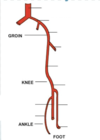Arterial Disease of the Limbs - Presentation, Investigation & Therapy Flashcards
Name the arteries


How do you examine for the aortic pulse?
Above the umbilicus. Use two hands to feel for pulsation vs expansion
How do you feel for the common femoral artery?
Mid-inguinal point, ½ way between the Anterior Superior Iliac Spine and the pubic symphysis
How do you feel for the popliteal artery?
Use both hands to feel deep in the popliteal fossa – leg relaxed into your hands
How do you find the posterior tibial pulse?
: ½ way between the medial malleolus and the achilles tendon
How do you find the dorsalis pedis pulse?
Lateral to the extensor hallucis longus tendon
What is the cause of CLI (critical limb ischaemia)?
Atherosclerotic disease of the arteries supplying the lower limb
What are the risk factors for CLI?
Male
Age
Smoking
Hypercholesterolaemia
Hypertension
Diabetes
What is stage 1 CLA according to the Fontaine classification?
Stage I: Asymptomatic, incomplete blood vessel obstruction
What is stage 2 CLA according to the Fontaine classification?
Mild claudication pain in limb
Stage IIA: Claudication when walking a distance of greater than 200 meters
Stage IIB: Claudication when walking a distance of less than 200 meters
What is stage 3 CLA according to the Fontaine classification?
Stage III: Rest pain, mostly in the feet
Critical limb ischaemia
What is stage 4 CLA according to the Fontaine classification?
Stage IV: Necrosis and/or gangrene of the limb
Critical limb ischaemia
Which leg does claudication usually impact?
Bilateral
What is typical past medical history for CLI?
Other signs of atherosclerosis (MI, Stroke?)
What drug might a CLI patient be taking?
control of diabetes, aspirin?
What is the significance of a CLA patient occupation?
Determines the type of treatment
What are the signs of chronic ischaemia on examination?
Ulceration
Pallor
Hair loss
What should you feel during examination of CLA?
Capillary refill times
Temperature
Pulses
Peripheral sensation (particularly in diabetics)
STARTING AT TOES AND ALWAYS COMPARING SIDES
How do you auscultate for CLA?
Hand held doppler (ultrasound machine)
Listening to the dorsalis pedis and the posterior ribial pulses
What are the special examination tests for CLI
Ankle brachial pressure Index
Measures Ankle pressure + Brachial pressure
Buerger’s test
What is the buerger’s test?
Elevate legs - pallor
Buergers angle below a 20 degree angle indicates severe ischaemia
Hang feet over the edge of the bed - slow to regain colour, should progress
Dark red colour (hyperaemic sunset foot).





